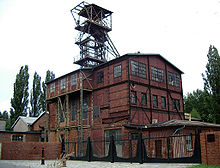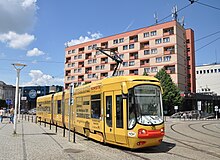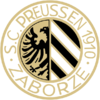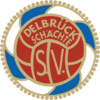Zabrze
| Zabrze | ||
|---|---|---|
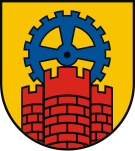
|
|
|
| Basic data | ||
| State : | Poland | |
| Voivodeship : | Silesia | |
| Powiat : | District-free city | |
| Area : | 80.47 km² | |
| Geographic location : | 50 ° 18 ′ N , 18 ° 47 ′ E | |
| Residents : | 172,806 (Jun. 30, 2019) |
|
| Postal code : | 41-800 - 41-820 | |
| Telephone code : | (+48) 32 | |
| License plate : | SZ | |
| Economy and Transport | ||
| Street : | Autostrada A4 | |
| Drogowa Trasa Średnicowa | ||
| Rail route : | Gliwice – Katowice | |
| Next international airport : | Katowice | |
| Gmina | ||
| Gminatype: | Borough | |
| Surface: | 80.47 km² | |
| Residents: | 172,806 (Jun. 30, 2019) |
|
| Population density : | 2147 inhabitants / km² | |
| Community number ( GUS ): | 2478011 | |
| Administration (as of 2013) | ||
| City President : | Małgorzata Mańka-Szulik | |
| Address: | ul. Powstańców 5/7 41-800 Zabrze |
|
| Website : | www.um.zabrze.pl | |
Zabrze [ ˈzabʒɛ ] ( German until 1915 Zabrze , then Hindenburg OS , since 1946 again Zabrze ) is a major Upper Silesian city in the Silesian Voivodeship in southern Poland about 150 km southeast of Wroclaw and about 90 km northwest of Krakow and an important center of the Upper Silesian industrial area (Mining, machine and iron industry).
geography
Geographical location
Zabrze borders on the cities of Gliwice (Gleiwitz), Bytom (Beuthen OS) and Ruda Śląska (Ruda) as well as on the districts ( Powiat ) Gliwicki and Tarnogórski .
City structure
The city of Zabrze covers an area of 80.4 km² with 17 districts:
- Biskupice ( Biskupitz-Borsigwerk )
- Centrum Północ ( north center )
- Center Południe ( South Center )
- Grzybowice ( mushroom village )
- Helenka ( Helenenhof )
- Kończyce ( Kunzendorf )
- Maciejów ( Mathesdorf )
- Makoszowy ( Mako Show )
- Mikulczyce ( Mikultschütz ; 1936–45: Klausberg OS )
- Osiedle Janek (translated: Janek settlement, new building after 1945)
- Osiedle Mikołaja Kopernika (translated: Nikolaus-Kopernikus-Siedlung, new building after 1945)
- Osiedle Młodego Górnika (translated: young miners' settlement, new building after 1945)
- Osiedle Tadeusza Kotarbińskiego
- Pawłów ( Paulsdorf )
- Rokitnica ( Rokittnitz ; 1936–45: Martinau )
- Zaborze Północ ( Zaborze-Poremba North )
- Zaborze Południe ( Zaborze-Poremba South )
history
The independent small settlement of Zabrze (later Alt-Zabrze) was first mentioned in the years 1295–1305 as "Sadbre sive Cunczindorf" (i.e. Saber or Cunczindorf = the village of Cunzen or Conrads) and was then under Bohemian , Habsburg and Prussian rule. The oldest settlement within the current urban area is Biskupitz (1243). Dorotheendorf was founded in 1774, and Klein-Zabrze in 1775 .
In 1873, the district office for the new Zabrze district was set up in the rural community of Alt-Zabrze . This originated from the south-western part of the district of Beuthen in the administrative district of Opole in the Prussian province of Silesia . The division of the district of Beuthen had become necessary because of the strong increase in the number of inhabitants as a result of industrialization.
On April 1, 1905, the municipalities of Alt-Zabrze, Klein-Zabrze and Dorotheendorf and the Zabrze manor district were combined to form the new municipality of Zabrze and Colony C of Zaborze was incorporated.
The rural community of Zabrze was renamed "Hindenburg OS" (OS = Upper Silesia) on February 21, 1915 by decision of the district and with this in honor of Field Marshal Paul von Hindenburg . After the dissolution of the province of Silesia in November 1919, the administrative district of Opole became the independent province of Upper Silesia . From then on, Hindenburg OS belonged to the province of Upper Silesia.
On October 1, 1922, the rural community of Hindenburg OS (the then "largest village in Europe") was granted city rights in accordance with the city regulations for the six eastern provinces of the Prussian monarchy of May 30, 1853. On January 1, 1927, the Hindenburg OS district was dissolved. The rural community and the Sosnitza manor district were incorporated into Gleiwitz , while the rural communities Biskupitz, Mathesdorf and Zaborze were incorporated into the town of Hindenburg OS, which has since formed its own urban district .
On April 1, 1938, the previous Prussian provinces of Lower Silesia and Upper Silesia were combined again to form the Province of Silesia, then on January 18, 1941, as a district, again divided into Upper and Lower Silesia. Hindenburg OS was spun off from the Opole administrative region and subordinated to the Katowice administrative region.
The synagogue, inaugurated in 1873, was opened during the Reichspogromnacht on 9/10. Burned down November 1938. 350 Jewish men were arrested and deported to the Buchenwald concentration camp .
On January 24, 1945, the city was conquered by the Red Army , placed under Polish administration on March 19, 1945 and then attached to the Silesian Voivodeship. The majority of the German population, unless they had fled, was expelled or subsequently expelled. In 1946 the city was given its previous name Zabrze again.
In 1950 the city became part of Katowice Voivodeship. In 1951 Makoszowy (Makoschau) , Kunzendorf, Paulsdorf, Mikultschütz, Rokittnitz, Pilzendorf were incorporated, later also Helenenhof.
In 1953 the city of Essen ( Ruhr area ) took over the sponsorship of Hindenburg OS. This sponsorship is currently understood as a sponsorship for the expelled and resettled Hindenburgers and their cultural assets. The “Hindenburg Home Collection” is also located in Essen. On March 15, 1991, the two-plus-four treaty came into force with which Zabrze's factual affiliation to Poland was also confirmed under international law. In 1999 Zabrze came to the Silesian Voivodeship and received the status of an independent city.
Population development
In the last census of 2002, 158,425 or 81.1% of the 195,293 inhabitants at that time claimed to be Polish, 3835 people (1.96%) described themselves as " Silesians " , 2592 (1.33%) as Germans and 123 ( 0.06%) as Roma . 30,113 people did not provide any information about their nationality. This means that Zabrze is home to a small, but nevertheless numerically and proportionately largest German minority of all cities in the Silesian Voivodeship.
politics
District administrators
- 1874–1887: Hans von Holwede
- 1887–1891: Arthur Sebastian von Falkenhayn
- 1891–1892: Theodor Parisius († 1892)
- 1892–1902: Alfred Scheche
- 1902–1907: Max Hermann Freiherr von Ziller (1867–1929)
- 1907–1912: Hermann Dihle (1873–1944)
- 1912–1920: Georg Wilhelm Suermondt (1868–1943)
- 1920–1927: Albrecht Müller von Blumencron
mayor
- 1923–1927: Kurt Jeenel
- 1927–1929: Hans Lukaschek (1885–1960) , center
- 1930–1933: Julius Franz (1881–1938) , SPD
- 1933–1945: Max Fillusch (1896–1965) , NSDAP
City Presidents
(after 1945)
- 1945 (end of February-mid-March): Sauer, Committee Free Germany
- 1945–1950: Paweł Dubiel
- 1950-1951: Grzegorz Sabuda
- 1951–1957: Rufin Suchoń
- 1957-1960: Jerzy Knapik
- 1960–1970: Tadeusz Bluszcz
- 1970–1973: Jerzy Skowronek
- 1974–1978: Bogusław Pałka
- 1978–1981: Hubert Niglus
- 1981-1987: Jan Janota
- 1987-1991: Gerard Hajda
- 1991–2002: Roman Urbańczyk
- 2002–2006: Jerzy Gołubowicz
- since 2006: Małgorzata Mańka-Szulik
At the head of the city administration there is a city president who is directly elected by the population. Since 2006 this has been Małgorzata Mańka-Szulik.
Mańka-Szulik also ran her own election committee in the 2018 election. The vote brought the following result:
- Małgorzata Mańka-Szulik (Electoral Committee Małgorzata Mańka-Szulik) 31.5% of the vote
- Agnieszka Rupniewska ( Koalicja Obywatelska ) 22.4% of the vote
- Kamil Żbikowski (“Better Zabrze” election committee) 15.5% of the vote
- Borys Borówka ( Prawo i Sprawiedliwość ) 15.4% of the vote
- Adam Kudzia (“Zabrze for All” electoral committee) 5.3% of the vote
- Lukas Kowalkowski ( Kukiz'15 ) 4.5% of the vote
- Mirosław Dynak ( Wolni i Solidarni ) 4.1% of the vote
- Remaining 1.4% of the vote
In the run-off election that was then necessary, the incumbent Mańka-Szulik narrowly prevailed against her strongest challenger Rupniewska with 51.6% of the vote.
City council
The city council consists of 25 members and is directly elected. The 2018 city council election led to the following result:
- Koalicja Obywatelska (KO) 27.0% of the vote, 9 seats
- Election Committee Małgorzata Mańka-Szulik 21.4% of the vote, 7 seats
- Prawo i Sprawiedliwość (PiS) 19.3% of the vote, 5 seats
- Election committee "Besseres Zabrze" 12.2% of the vote, 3 seats
- Kukiz'15 7.8% of the vote, 1 seat
- Election committee “Zabrze for all” 4.1% of the vote, no seat
- Sojusz Lewicy Demokratycznej (SLD) / Lewica Razem (Razem) 3.7% of the vote, no seat
- Wolni i Solidarni (WiS) 2.7% of the vote, no seat
- Remaining 2.0% of the vote, no seat
coat of arms
The coat of arms of Zabrze shows a red brick tower with battlements and a blue cogwheel on a gold background. It was used between 1927 and 1948 and again since 1990 in a slightly modified form.
Town twinning
Zabrze has partnerships with the following cities:
-
 Essen , North Rhine-Westphalia, sponsorship through Hindenburg OS since 1953 , close urban cooperation (cooperation) on the basis of the existing sponsorship since 2000, a cooperation document was signed in 2008, the town twinning was decided on March 25, 2015
Essen , North Rhine-Westphalia, sponsorship through Hindenburg OS since 1953 , close urban cooperation (cooperation) on the basis of the existing sponsorship since 2000, a cooperation document was signed in 2008, the town twinning was decided on March 25, 2015 -
 Sangerhausen , Saxony-Anhalt, since 1983
Sangerhausen , Saxony-Anhalt, since 1983 -
 Seclin , France, since 1987
Seclin , France, since 1987 -
 Lund , Sweden, since 1992
Lund , Sweden, since 1992 -
 Rotherham , England, since
Rotherham , England, since -
 Trnava , Slovakia, since 1995
Trnava , Slovakia, since 1995 -
 Kaliningrad , Russia, since 1998
Kaliningrad , Russia, since 1998 -
 Rivne , Ukraine, since 2001
Rivne , Ukraine, since 2001 -
 Zahlé , Lebanon, since 2007
Zahlé , Lebanon, since 2007
Attractions
- Main post
- " Admiralspalast " (office and commercial building with hotel and restaurant, built 1925–1927 by the Berlin architects Richard Bielenberg and Josef Moser )
- Borsigwerk settlement
- Anna Church
- Josefskirche (1930–1931 by Dominikus Böhm )
- New theater
- Coal Mining Museum
- Andreas Church
- Schrotholzkirche
- " Queen Luise " disused mine and mining museum
- Water tower
- Clinic (former Knappschafts Hospital) with water tower (1906–1907)
- Guido Mining Museum , an anchor point on the European Route of Industrial Heritage .
economy
Today Zabrze is an important scientific, cultural and industrial center in the Upper Silesian industrial area . Among other things, the institutes of the Polish Academy of Sciences , the Upper Silesian Philharmonic and companies in the electronics , glass and food industries are located here . Mining has been practiced in the region since 1841 .
traffic
Zabrze station is on the Katowice – Legnica railway line . Some freight routes also run through the city.
In local transport there is a connection to the Upper Silesian tram network .
The city has a connection to the Polish autostrada A4, and the Drogowa Trasa Średnicowa runs through Zabrze.
Recreation
The Voivodeship Culture and Recreation Park and Maciejów Park (formerly “Mathesdorf Forest”) serve as recreational areas for the residents of Zabrze. The botanical garden was laid out in the 1930s. One of the sights is the Zabrze water tower .
Sports
Football in Hindenburg O / S. before 1945
The successful Hindenburg club was SC Preußen Hindenburg, founded in 1910 . He played in the top football league, at that time the Gauliga Schlesien at regional level and from 1941 the Gauliga Oberschlesien , and once took part in the final round of the German championship. In addition there were still O / S in Hindenburg. the following football clubs: the SpVgg Deichsel , the TV Deichsel , the TuS Hindenburg 09 , the SV Delbrückschächte , the SV Borsigwerk and the Sportfreunde Klausberg .
Football in Zabrze after 1945
The importance of sport in Zabrze can be seen in the soccer club Górnik Zabrze , which is the Polish record champion with 14 titles, but has not won a championship since 1988, unlike the 13-time champion Wisła Krakow .
Personalities
Honorary citizen
- Heinz Tobolla (1925–2013), sculptor and artist, since 2007 honorary citizen of the city of Zabrze
- Janosch (* 1931), German illustrator, children's book author and writer, honorary citizen since 2011
- Peter Hadaschik (* 1968), German-Polish electrical engineer, honorary citizen of the city of Zabrze since 2016
sons and daughters of the town
politic and economy
- Siegfried Deinege (* 1955), German engineer and local politician, Mayor of Görlitz
- Helmut Dittrich (1926–1987), German police officer, politician (SPD) and member of the Bremen citizenship
- Franz Drescher (1871–1934), German industrialist
- Karl Godulla (1781–1848), Prussian "zinc king"
- Friedrich Kramer (* 1938), German politician (CDU)
- Ilse Ridder-Melchers (* 1944), German politician (SPD)
- Erich Rußek (1893–1945), German politician (NSDAP)
- Werner Sobetzko (* 1939), German politician (CDU)
Science, education, media
- Rafael Buschmann (* 1982), German journalist
- Joachim Dalfen (1936–2017), Austrian classical philologist of German origin
- Günter Dörner (1929–2018), German physician, professor of endocrinology
- Adolf Hoffmann-Heyden (1877–1964), German surgeon and university professor
- Maritta Hübner (1930–1989), German radio play director
- Janpeter Kob (1927–1986), German sociologist
- Günter Kohlmann (1933–2005), German professor of criminal law
- Günter Kolodziej (1924–1996), German band leader, choir director, conductor and composer
- Bernhard Kytzler (* 1929), German classical philologist
- Erich Muscholl (1926-2019), German scientist (medicine)
- Friedrich Nowottny (* 1929), German television journalist
- Heinrich Opitz (1929–2018), German Marxist philosopher
- Sibylle Penkert (* 1935), German literary scholar
- Paul-Georg Schmidt (1902–1987), German pulmonologist
- Peter Toschek (1933–2020), German physicist
Arts and Culture
- Robert Bednorz (1882–1973), German sculptor
- Helmut Calgéer (1922–2010), German musician, music teacher and conductor
- Werner Cyprys (1922–2000), German singer, composer and music producer
- Edeltraud Eckert (1930–1955), German writer
- Halina Golanko (* 1948), Polish actress
- Barbara Grabowska (1954–1994), Polish actress
- Monika Grzymala (* 1970), Polish installation artist
- Werner Heiduczek (1926–2019), German writer
- Janosch (actually: Horst Eckert , * 1931), German children's book author
- Jan Jargoń (1928–1995), Polish organist and composer
- Adam Jaskolka (* 1979), German actor
- Krista Keller (1931–1988), German actress and theater director
- Joachim Kerzel (* 1941), German actor
- Dieter Olaf Klama (* 1935), German artist
- Justina Klimczyk (* 1973), German stage and costume designer
- Siegfried Lohr (1935–2017), German architect, building historian and draftsman
- Daze Maxim (actually: Markus Stanislaw Manowski , * 1977), German musician
- Johannes Mronz (1930–1998), German architect
- Marian Oslislo (* 1955), Polish artist, rector and professor of the Academy of Fine Arts in Katowice
- Kurt Prokscha (1919–1998), German conductor
- Margarete Stokowski (* 1986), Polish-German columnist and author
- Wilhelm Tkaczyk (1907–1982), German poet, translator and librarian
- Heinz Tobolla (1925–2013), German sculptor and artist, since 2007 honorary citizen of the city of Zabrze
- Adrian Topol (* 1981), German actor
- Dorothee von Velsen (1883–1970), German writer and women's rights activist
- Andrzej Walter (* 1969), Polish poet, writer, publicist, literary critic and photographer
- Horst Wrobel (* 1935), German designer, founder of the Gifhorn Mill Museum and holder of the Cross of Merit on Ribbon of the State of Lower Saxony
- Krystian Zimerman (* 1956), Polish pianist
Sports
- Tomasz Bandrowski (* 1984), Polish football player
- Adam Bodzek (* 1985), German-Polish soccer player
- Jerzy Gorgoń (* 1949), Polish football player
- Werner Janik (1920–2003), soccer player and coach
- Zbigniew Jaremski (1949–2011), Polish sprinter
- Henryk Kasperczak (* 1946), Polish football player and coach
- Rudolf Kozłowski (* 1935), Polish weightlifter
- Waldemar Ksienzyk (* 1963), German soccer player
- Fritz Laband (1925–1982), German soccer player
- Siegmund Mainka (* 1968), German Paralympics winner in sailing
- Kurt Mansfeld (1910–1984), German motorcycle racer
- Siegfried Schubert (Silla) (* 1939), German ice hockey player and coach
- Łukasz Skorupski (* 1991), Polish football goalkeeper
- Adrian Spyrka (* 1967), German soccer player
- Paul Thomik (* 1985), German-Polish soccer player
- Kurt Tschenscher (1928–2014), German football referee
- Wojtek Wolski (* 1986), Canadian ice hockey player

Others
- Joachim Kroll (1933–1991), German serial killer
Other personalities
- Carl Szmula (1828–1890), doctor in Zabrze
- Reinhold Altmann (1865–1934), chief physician at the Knappschaftslazarett in Zabrze
- Franciszek Trąbalski (1870–1964), Polish socialist politician (PPS, PZPR)
- Rudolf Hartmann (1856–?), Chief physician at the Knappschaftslazarett in Zabrze and politician
- Manfred Skutta (1932–2006), lawyer, judge, director of the local court
- Horst Sylla (* 1933), Lieutenant General of the National People's Army
Trivia
The mining town of Zabrze is mentioned as the hometown of the pseudo-Polish family of musicians Popolski . From there the Popolski Show “Live from the Plattenbau” is fictionally broadcast.
literature
- Josef Knossalla: History of the city of Hindenburg O / S. (Zabrze) shown in single images on the occasion of the city's development , Kattowitz 1929 ( digitized )
- Residential address book Hindenburg OS 1909, 1912, 1938 . ( Digitized version )
- Josef Pollok: " Hindenburg OS, City of Mines and Huts ", Essen 1979. ( digitized version )
- Kalendarium Zabrzanske , Zabrze 2006
Web links
- City website
- History of the city on "Oberschlesien aktuell"
- History of the city with history on demand
- the current Hindenburg home letter
Individual evidence
- ↑ a b population. Size and Structure by Territorial Division. As of June 30, 2019. Główny Urząd Statystyczny (GUS) (PDF files; 0.99 MiB), accessed December 24, 2019 .
- ↑ See http://www.um.zabrze.pl/mieszkancy/miasto/statystyki
- ↑ See http://www.um.zabrze.pl/mieszkancy/miasto/dzielnice
- ^ Hindenburg - Zabrze (Upper Silesia). Retrieved May 24, 2017 .
- ↑ Cf. Main Office of Statistics (GUS) ( Memento from December 17, 2012 in the Internet Archive )
- ↑ Result on the website of the election commission, accessed on July 30, 2020.
- ↑ Result on the website of the election commission, accessed on July 30, 2020.
- ↑ See http://www.um.zabrze.pl/mieszkancy/samorzad/miasta-partnerskie
- ↑ https://www.essen.de/mektiven/pressemeldung_918186.de.html







